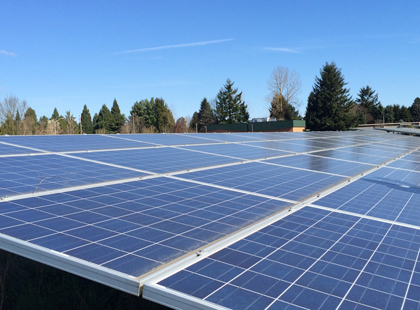Sometimes good things lurk in the FOG. In this case, FOG is a waste product—fats, oils, and grease, and it’s a major reason why the City of Gresham was able to turn its wastewater treatment plant from an energy hog into the first in the Pacific Northwest to achieve net-zero energy consumption, and one of only a handful in the nation. You can see their short story here:
Wastewater treatment plants are extremely energy intensive, and Gresham’s plant was consuming one-half of all energy used in city operations, enough to power more than 450 homes.
Faced with rising utility bills and limited city funds, the city set the ambitious goal to first improve energy efficiency and then generate renewable electricity to power the rest of the facility’s energy needs. Reaching that net-zero goal took vision, persistence, and determination, and the payoff is significant: the city will save $500,000 in electricity costs every year, and pass that savings on to ratepayers.
The Right Ingredients
Gresham had the right mix of ingredients to succeed, starting with an energy champion in Alan Johnston, the plant’s senior engineer. Alan facilitated achievement of the plant’s goal of reaching net-zero with the help of his energy management team, a supportive mayor and city council, and financial and technical assistance from key supporters Energy Trust of Oregon and Oregon Department of Energy.
The city’s journey began with sewage sludge. In 1990, the city started harvesting biogas produced through anaerobic digestion of sludge, creating renewable energy and heat to run the plant. The more wastewater the city treated, the more biogas it produced. Fifteen years after it got into the biopower business, the city, with help from Energy Trust, replaced its old co-generation engine with a larger, 395-kW engine, making it possible for existing biogas to meet 50 percent of the plant’s power needs.
This inspired Alan to go further. In 2009, Alan and the energy management team set their sights on becoming a net-zero energy facility in five years. First, the city installed a large ground-mounted solar array—a 420-kilowatt solar electric system that supplies about 8 percent of the plant’s electricity needs. The energy team also implemented a number of energy-efficiency improvements that reduced the plant’s energy use by 17 percent. Finally, in late 2014, the city added a second co-generation engine that increased energy generation capacity.
FOG’s Starring Role
But the star of this story is really the FOG. Gresham is turning this waste product into a resource that helps make net-zero energy possible. Restaurants and other commercial food establishments produce FOG, which is typically collected in grease traps and landfilled to avoid clogging the sewer system. In 2012, the city doubled its biogas production when it installed a FOG receiving and processing facility. Collecting the FOG and injecting it into the digesters increased the amount of biogas produced and fed into the co-generation engines. In total, renewable biogas now supplies 92 percent of the plant’s power needs.
As of February 2015, the plant was generating more electricity from onsite renewable energy than it needed from its utility to operate. In addition to saving $500,000 a year, using renewable energy protects the city from rising energy costs and allows it to pass the savings on to its wastewater customers in the form of lower rates.
As an added benefit, the city collects about $250,000 a year in tipping fees from FOG haulers. The plant also recycles leftover biosolids, delivering them to local farmers to use as fertilizer for nonedible agricultural products.
Cities Leading the Way to a Low Carbon Future
While Gresham’s journey is impressive, its circumstances are by no means unique, and its success can be replicated at wastewater treatment plants across the U.S. With cities responsible for 70% of carbon emissions globally, transforming the way cities are powered is critical to solving the climate crisis. Gresham’s story demonstrates how cities are leading the way to a low carbon, clean energy future.





